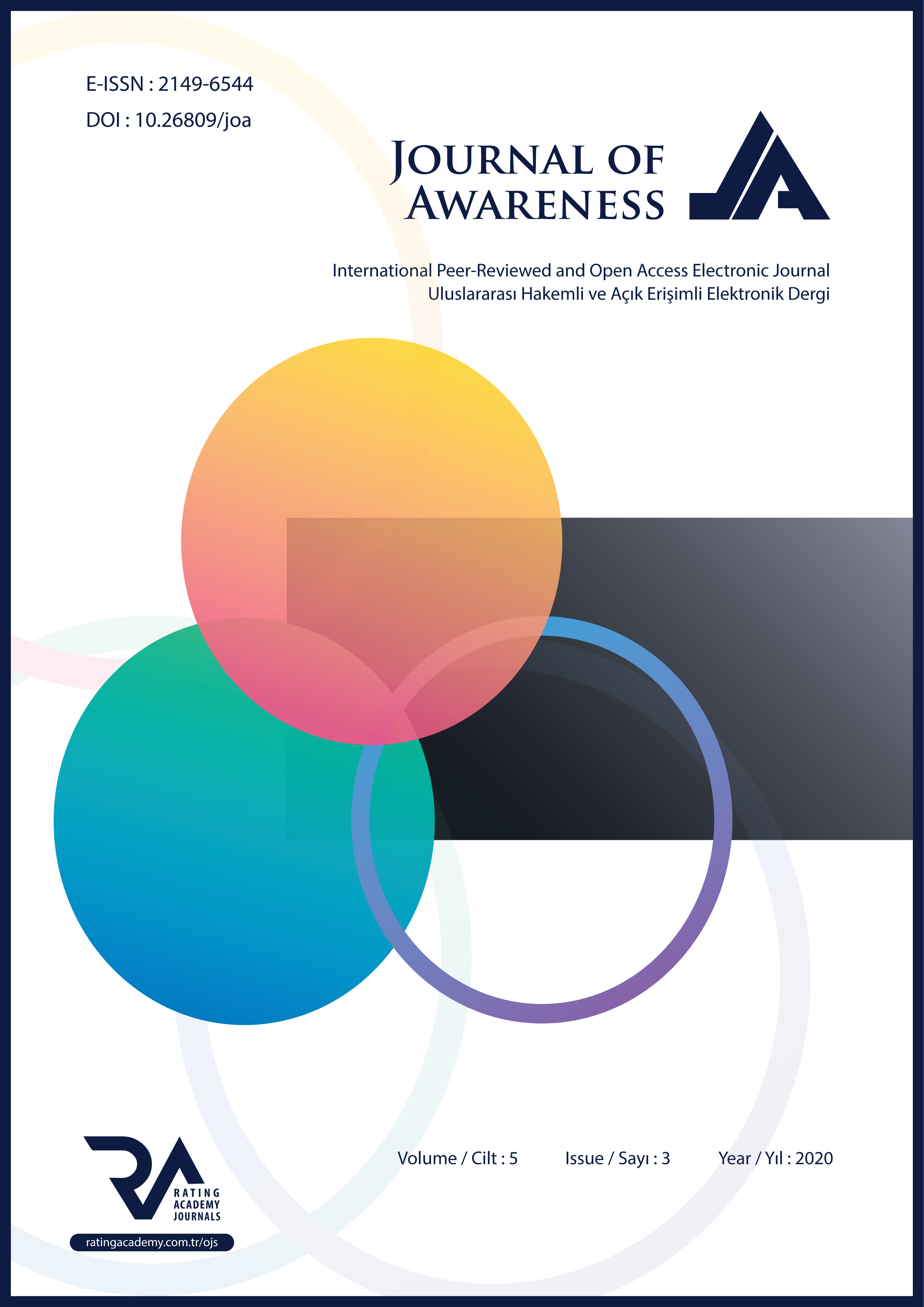CONSTRUCTING THE CONCEPT OF THE PHYSICAL INTERNET AS OPPOSED TO THE CONCEPT OF LOGISTICS WITH A VIEW TO ESTABLISHING THE PARADIGM OF SOCIETY-BUSINESS-TECHNOLOGY AS PART OF INDUSTRY 4.0
DOI:
https://doi.org/10.26809/joa.5.022%20Anahtar Kelimeler:
Industry 4.0- Internet of Things- Internet of Services- Physical Logistics- DigitalizationÖzet
Concepts such as present-day mentality, human activities, technology, social and economic environments and organisational climate have had to undergo constant change following Industrial Revolutions. These changes in the management world have created a new value in production and service sectors. Supported by technology and device s that autonomously communicate with each other, these chains have ensured more modernized production processes. As the most recent trend, Industry 4.0 provides appropriate systems, physical attributes and diverse technologies that can cater for the future needs of economies by means of its initiation into business life with the motto of technological change and restructuring.
The present study aim stories awareness of the concept of the Physical Internet, which is believed to provide new solutions to the field of logistics, and is an open global logistic system that has re defined existing supply chain structures, as well as current business and value creating models. This concept provides privileges in terms of transporting abstract and concrete products of enter prises via internet all over the world, as well as storing and supplying them.
Consequently, the aim of the present study includes theoretically analysing the concept of the Physical Internet, which is one of the technological solutions provided by Industry 4.0, by means of literature review, which is defined as second-hand data, along with developing a different view point on enterprises’ vision and knowledge, and ensuring that enterprises do not miss the opportunity to restructure themselves. For an enterprise to be powerful, it is required to seize on opportunities and employ them in internal dynamics. Hence, if enterprises aspire to create value chains in the in activities, they should primarily seize on opportunities with the help of Industry 4.0, which is considered to be the future industrial revolution, adapt them to their own structures, and, in turn, be new generation enterprises by raising awareness.
Concisely, the aim of the study is to bring a new perspective on logistic activities with the concept of the Physical Internet, ensure there vision of the current situation, and offer a solution to society-business-technology paradigm.
İndirmeler
Referanslar
Acatech. (2013). National Acedemy Of Science and Engineering, Recommendations For Implementing The Strategic Initiative Industrie4.0, Germany, April.
ANDREJIOVÁ, M., PAVLISKOVÁ, A., &HUSÁKOVÁ, N. (2012). Application of multicriterion decision methods by the selection of optimal constructive elements for devices of continuous transport. CarpathianLogist. Congr., TANGER LTD. Ostrava, 1-6.
BALLOT, E., GOBET, O., &MONTREUIL, B. (2012). Physical internet enabled open hub network design for distributed networked operations. In Service orientation in holonic and multi-agent manufacturing control (pp. 279-292). Springer Berlin Heidelberg.
BARBARINO S., (2015). A new concept for logistics: a Physical Internet, Presentation at GS1 Transport &Logistics Workshop (12–13 October 2015, Warsaw, Poland).
BAUERNHANSL, T., TEN HOMPEL, M., &VOGEL-HEUSER, B. (Eds.). (2014). Industrie 4.0 in Produktion, Automatisierung und Logistik: Anwendung, Technologien und Migration (pp. 1-648). Wiesbaden: Springer Vieweg.
BRETTEL, M., FRIEDERICHSEN, N., KELLER, M., &Rosenberg, M. (2014). How virtualization, decentralization and network building change the manufacturing landscape: An industry 4.0 perspective. International Journal of Mechanical, Industrial Science and Engineering, 8(1), 37-44.
ÇANCI, M., & ERDAL, M. (2003). Logistics Management, Freight Forwarder Manual 1. UTİKAD Publishing, Istanbul.
FEDORKO, G., HUSAKOVA, N., &DUDAS, G. (2010). Design of allocation of new technological equipment within the frame of production process in company Getrag Ford Transmissions Slovakia, sro. Acta Montanistica Slovaca, 15, 14-22.
FOUNOU, R. (2002). The Role of IT in Logistics, Competitive Advantage or Strategic Necessity?. In 2nd Swiss Transport Research Conference (pp. 1-21).
HERMAN, M., PENTEK, T., &OTTO, B. (2015). Design principles for Industry 4.0 Scenario: A literature review.
LANDSCHÜTZER, C., EHRENTRAUT, F., &JODIN, D. (2015). Containers for the Physical Internet: requirements and engineering design related to FMCG logistics. LogisticsResearch, 8(1), 8.
MASLARIĆ, M., NIKOLIČIĆ, S., &MIRČETIĆ, D. (2016). Logistics response to the industry 4.0: the physical internet. Open Engineering, 6(1).
Momnet. (2014). Germany and Industry 4.0 Hacettepe University Faculty of Communication Journal of Cultural Studies. April, 2014.
MONTREUIL, B. (2012). Physical Internet Manifesto, version 1.11. 1. CIRRELT InteruniversityResearch Center on Enterprise Networks, Logistics and Transportation.
MONTREUIL, B. (2011). Toward a Physical Internet: meeting the global logistics sustainability grandchallenge. Logistics Research, 3(2-3), 71-87.
PORTER, M. E., &HEPPELMANN, J. E. (2014). WiesmarteProdukte den Wettbewerbverändern. Harvard Business Manager, 12(2014), 34-60.
RUSHTON, A. (2007). International logistics and supply chain outsourcing: from local to global. Kogan Page Publishers.
SALLEZ, Y., MONTREUIL, B., &BALLOT, E. (2015). On the activeness of physical internet containers. In Service Orientation in Holonic and Multi-agent Manufacturing (pp. 259-269). Springer International Publishing.
SMIT, J., KREUTZER, S., MOELLER, C., &CARLBERG, M. (2016). Industry 4.0. Study for the ITRE Committee, Policy Department A: Economic and Scientific Policy, European Parliament, Brussels.
STOJANOVIĆ, Đ. (2012). Paradoxes and opportunities in logistic outsourcing research. PROMET-Traffic&Transportation, 24(6), 525-533.
TAYLOR, G. D. (Ed.). (2008). Introduction to logistics engineering. CRC Press.
İndir
Yayınlanmış
Nasıl Atıf Yapılır
Sayı
Bölüm
Lisans
Telif Hakkı (c) 2020 Holistence Publications

Bu çalışma Creative Commons Attribution 4.0 International License ile lisanslanmıştır.
Yazarlar, makale Journal of Awareness’de yayınlanmak üzere kabul edildiğinde.makalenin içeriğindeki tüm telif haklarını, Rating Academy Ar-Ge Yazılım Yayıncılık Eğitim Danışmanlık ve Organizasyon Ticaret Ltd. Şti’ne devrederler. Yazarlar, patent hakları gibi telif hakkı dışındaki tüm mülkiyet haklarını saklı tutar.
Bu makalede yazar olarak listelenen herkes çalışmaya önemli, doğrudan, entelektüel katkılar yapmış olmalı ve bunun için kamu sorumluluğu almalıdır.
Bu makale daha once yayınlanmamış ve başka dergilerde yayınlanmak üzere gönderilmemiştir.










